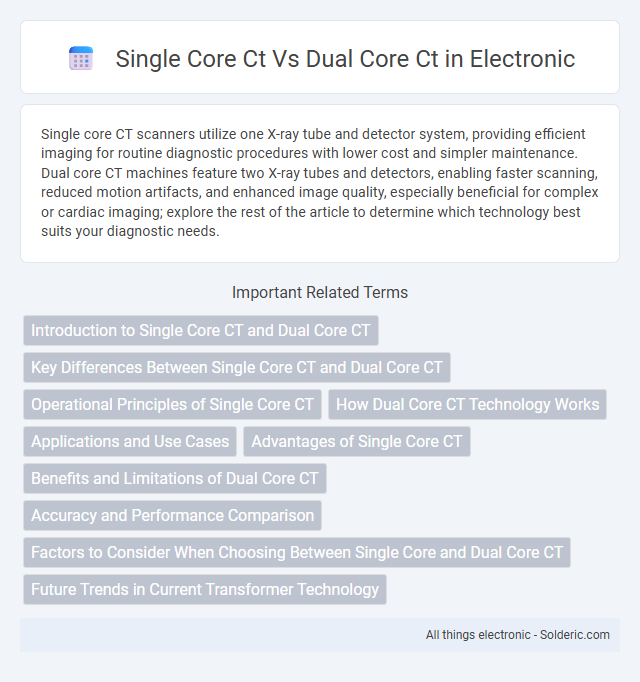Single core CT scanners utilize one X-ray tube and detector system, providing efficient imaging for routine diagnostic procedures with lower cost and simpler maintenance. Dual core CT machines feature two X-ray tubes and detectors, enabling faster scanning, reduced motion artifacts, and enhanced image quality, especially beneficial for complex or cardiac imaging; explore the rest of the article to determine which technology best suits your diagnostic needs.
Comparison Table
| Feature | Single Core CT | Dual Core CT |
|---|---|---|
| Processor Cores | 1 Core | 2 Cores |
| Performance | Basic, suitable for simple tasks | Higher, supports multitasking and complex applications |
| Speed | Lower processing speed | Faster processing speed due to parallelism |
| Power Consumption | Lower power consumption | Higher power consumption but optimized for efficiency |
| Cost | Generally lower cost | Typically higher cost due to added cores |
| Use Case | Simple applications, cost-sensitive projects | Complex applications, multitasking, performance-critical tasks |
Introduction to Single Core CT and Dual Core CT
Single Core CT systems utilize a single processing unit for image reconstruction, offering simplicity and cost-effectiveness ideal for basic diagnostic tasks. Dual Core CT employs two processing units simultaneously to enhance image quality and speed, enabling more complex diagnostics and faster patient throughput. Your choice depends on balancing clinical requirements with budget constraints and desired imaging performance.
Key Differences Between Single Core CT and Dual Core CT
Single core CT scanners use a single X-ray tube and detector, providing slower image acquisition and lower spatial resolution compared to dual core CT systems, which feature two X-ray tubes and detectors for faster scanning and enhanced image quality. Dual core CT excels in cardiac and dynamic studies due to its ability to capture images with reduced motion artifacts and improved temporal resolution. Your choice depends on clinical requirements, with dual core CT offering superior performance in complex diagnostic scenarios.
Operational Principles of Single Core CT
Single core CTs operate using a single sensing element that produces one output signal representing current flow, relying on a single magnetic core to encircle the conductor. This design simplifies installation and is typically used for monitoring one phase or current conductor at a time, making it efficient for straightforward current measurement applications. The single core transforms the primary current into a proportional secondary current, maintaining accuracy within a specified range for protection and metering systems.
How Dual Core CT Technology Works
Dual Core CT technology uses two X-ray sources and two detectors that operate simultaneously, capturing images from different angles to enhance scan speed and image clarity. This dual energy approach allows for better tissue characterization and more precise differentiation of materials within the body. Your diagnostic accuracy improves significantly with Dual Core CT, as it provides higher resolution images and reduces motion artifacts compared to single core CT systems.
Applications and Use Cases
Single core CT scanners are ideal for routine imaging tasks such as chest X-rays, basic abdominal scans, and emergency trauma evaluations due to their faster rotation speeds and simplicity. Dual core CT systems excel in complex applications including cardiac imaging, vascular studies, and high-resolution brain scans, offering enhanced image quality and improved temporal resolution for dynamic assessments. Your choice depends on the clinical requirements; single core CT suits general diagnostic use, while dual core CT is preferred for specialized, high-detail examinations.
Advantages of Single Core CT
Single Core CT systems offer advantages such as higher spatial resolution and more precise image quality, which is essential for detailed diagnostic imaging. You benefit from faster scan times and reduced motion artifacts, making single core CT ideal for high-resolution vascular and cardiac imaging. These systems often have lower radiation doses compared to dual core CT, enhancing patient safety during the diagnostic process.
Benefits and Limitations of Dual Core CT
Dual core CT scanners provide enhanced imaging speed and resolution by utilizing two X-ray sources and detectors simultaneously, allowing for faster data acquisition and improved temporal resolution compared to single core CT systems. These advantages facilitate superior detection of small lesions and better imaging in motion-prone organs, such as the heart, thereby increasing diagnostic accuracy and patient throughput. However, dual core CT units are more complex, costly to maintain, and may expose patients to higher radiation doses if scanning protocols are not optimized.
Accuracy and Performance Comparison
Dual core CT scanners provide enhanced accuracy by capturing images with finer detail and faster rotation speeds, reducing motion artifacts and improving diagnostic precision. Single core CTs often have longer scan times and lower spatial resolution, which can limit performance in high-demand clinical settings. Your choice between single and dual core CT will impact both image quality and scanning efficiency, with dual core systems offering superior performance for complex cases.
Factors to Consider When Choosing Between Single Core and Dual Core CT
When choosing between single core and dual core CT scanners, consider factors such as scan speed, image resolution, and clinical application requirements. Dual core CT systems offer faster acquisition and enhanced image quality, ideal for complex or high-volume imaging needs, while single core CT units may suffice for routine scans with lower throughput demands. Your decision should balance budget constraints, patient throughput, and diagnostic accuracy to ensure optimal clinical outcomes.
Future Trends in Current Transformer Technology
Future trends in current transformer (CT) technology emphasize increased accuracy and enhanced fault detection capabilities, with dual core CTs offering improved signal processing and reduced electromagnetic interference compared to single core CTs. Integration of smart sensors and IoT connectivity in dual core CTs enables real-time monitoring and predictive maintenance, optimizing your electrical system's performance. Advances in materials and digital algorithms further position dual core CTs as the preferred solution for evolving power grid demands and renewable energy integration.
single core ct vs dual core ct Infographic

 solderic.com
solderic.com